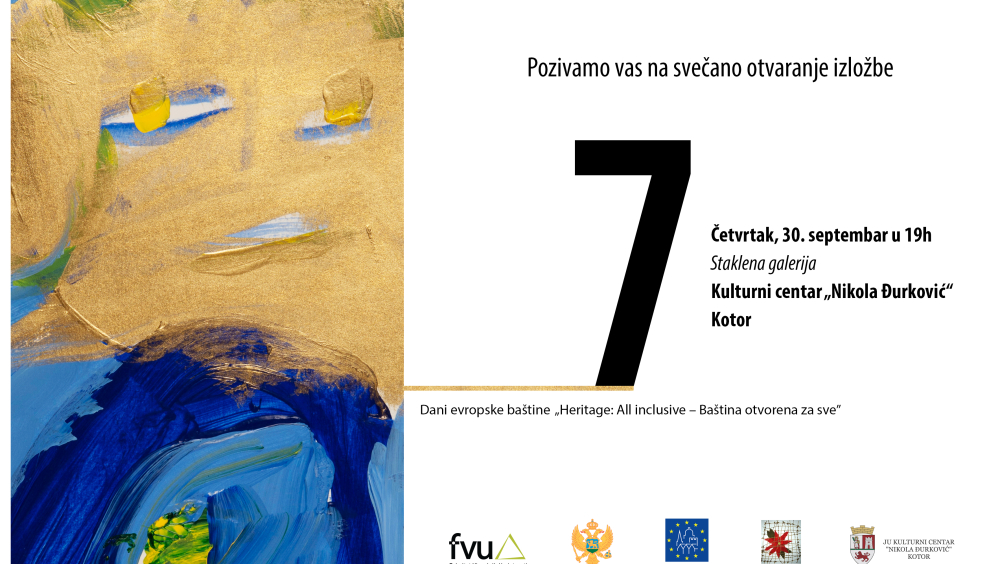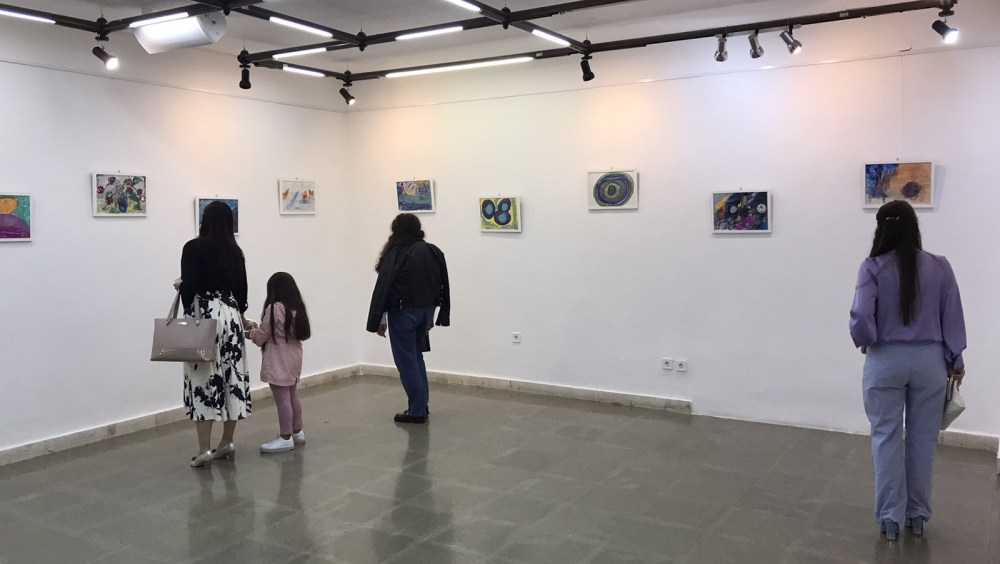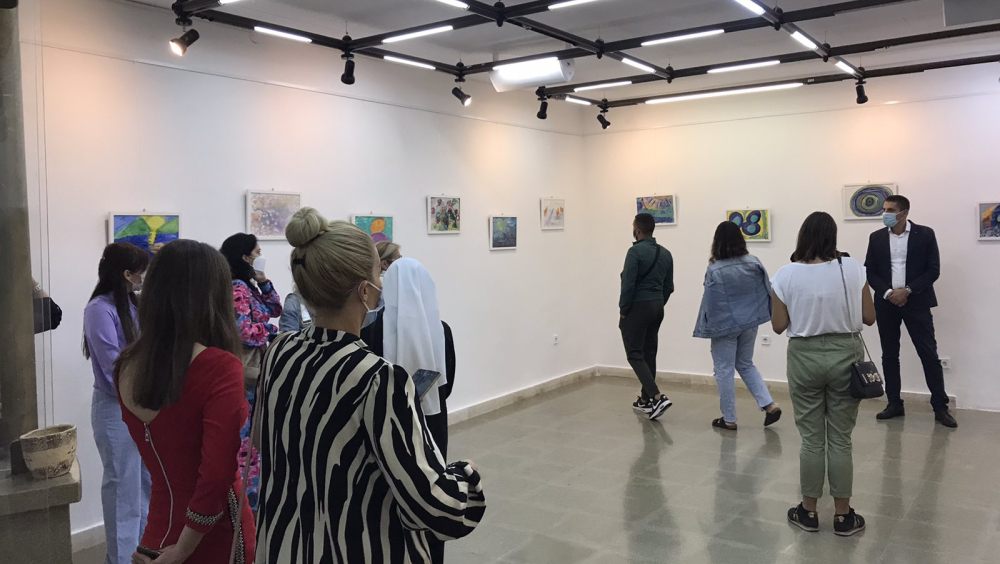ART THERAPY PROJECT - „A WORK OF ART IS A SCREAM OF FREEDOM“ CHRISTO
Art therapy project is a 2021 developed initiative created by the group of artists from the Faculty of Visual Arts, University “Mediterranean” Podgorica, Montenegro & medical staff of the Psychiatric Hospital “Dobrota” (psychiatrists, defectologists, nurses, and others). It is an ongoing project, developed by professionals in the fields of Arts and Medicine through the cooperation of two institutions: the psychiatric hospital “Dobrota” & the Faculty of Visual Arts, University “Mediterranean” Podgorica.
Art therapy, created in a form of post-Covid reaction to the world, in which artists, professors, and students together with the psychiatrists and other medical staff of the Dobrota Psychiatric Hospital developed a creative process of healing patients with mental illness through the use of art media.
It is the project, developed jointly (by doctors and artists) and has been implemented through a set of workshops. The series of workshops organized twice a week for the period of six months has created the therapeutic relationship to explore the feelings of the patients, reconciliation, emotional conflicts, and development of social skills, and increment of self-esteem.
The main results of such an initiative are a) to improve conditions of hospital patients, b) to facilitate a better understanding of mental illness, and c) to support the process of overcoming the stigma of mental illness in Montenegro.
Developed by artists with the support of medical staff, these therapeutic sessions served to improve conditions of hospital patients, to create new possibilities in healing, and as well new fields of communication for patients and psychiatrists, but also for artists and other medical staff included in the process.
Art therapy provides individuals facing physical, emotional, and cognitive challenges with new pathways toward understanding and self-expression. This form of treatment is more than an art class or just something to keep people occupied. Art therapy uses the power of the arts and different modes of communication to get people to open up and engage with their therapy in new ways, which may enhance healing of all kinds. This program has an important role, taking into consideration that the psychiatric hospital “Dobrota” was built in 1953, and since then it has been the only inpatient institution for psychiatric health care in Montenegro.
As an only stationary institution, the Dobrota hospital intended to care for, treat and improve and rehabilitate the health of mentally ill people. It is a public institution with eight buildings and 260 patients stationed in the institution in 2021. In order to develop better conditions for the patients among which the majority of them live in Dobrota for more than a decade, medical staff has decided to take a step forward and to develop and include a new & holistic approach in the process of mental health recovery. In cooperation with the artists from the Faculty of Visual Arts - modern education institution, distinctive in its person-centered and career-focused approach to education and teaching, the Art therapy project has been developed in the form of a creative process of healing patients with mental illness through the use of art media with the resulting artwork.
The artistic support for the project development was provided by the Faculty of Visual Arts - an institution focused on shaping a better world. The students of the Faculty are much more than a matriculation number and the professors are very committed to providing an optimum balance of theoretical and practical learning. Renowned for immediately relevant research and innovation, the Faculty of Visual Arts is very active in society. Since its foundation in 2006, the Faculty and the University as a whole, is committed to enhancing the quality of studies in a systematic and organized manner in order to be modern, flexible, comparable, competitive, and efficient. Therefore Art therapy project has been created as a joint initiative communicated and reflected through the previous joint experience developed through a set of humanitarian activities done by the Faculty of Visual Arts.
Art therapy as a form of practice, although has been an integral part of the human experience for thousands of years, is a relatively new development, with artists from the United Kingdom first describing it in the 1940s. The establishment of art therapy as a unique and publicly accepted therapeutic approach only took place recently, in the mid-20th century. The emergence of art therapy as a profession arose independently and simultaneously in Europe and the United States. The term “art therapy” was coined in 1942 by British artist Adrian Hill, who discovered the healthful benefits of painting and drawing while recovering from tuberculosis. In the 1940s, several writers in the mental health field began to describe their work with people in treatment as “art therapy.” As there were no formal art therapy courses or training programs available at that time, these care providers were often educated in other disciplines and supervised by psychiatrists, psychologists, or other mental health care professionals.
Names like Margaret Naumburg, Hanna Kwaitkowska, Florence Cane, and Edith Kramer have significance in this field and were influential writers of the 1940s by making contributions toward the development of art therapy as a recognized field. Margaret Naumburg, often described as the “mother of art therapy,” established the Walden School in her home city of New York in 1915. She is widely viewed as the primary founder of the American art therapy movement. Naumburg believed children who were allowed to express themselves creatively and pursue subjects of interest to them would experience healthier development. Influenced by the psychoanalytic movement prevalent at the time, Naumburg began to view the creative process as a methodology similar to verbal expression—a means of unearthing repressed, unconscious thoughts and emotions. Margaret Naumburg, became influenced by the first wave of psychoanalytic theory in the early 20th century. She believed that through the creative process, individuals brought to light unconscious thoughts and feelings that they might have repressed. Hanna Kwiatkowski, another major contributor, was born in Poland and educated throughout Eastern Europe. A talented sculptor and artist, Kwiatkowski eventually moved to the United States and began working at the National Institutes of Mental Health, where she bridged the gap between her passion and her profession by introducing art into the therapy sessions she conducted with families. As a result of these sessions, Kwiatkowska found the creative expression of drawing to allow family members to better identify their roles and status within the family. She also saw the significant therapeutic benefits of the drawing process. Other contributors include Florence Cane, an art educator who utilized teaching methods emphasizing the importance of free artistic expression and encouraging emotional creativity, and Edith Kramer, who proposed the more process-oriented art-as-therapy approach that defined goals of supporting the who, helping the development of identity, and fostering growth.
Today, Art therapy is a deep process based on psychodynamic, existential, and humanistic directions that use creative media as a basic element of communication - artistic, physical, musical-dramatic expression as a means of expressing emotions and thoughts, and resolving psychological conflicts in the triad relationship between patient and art product (image, movement, work) and therapist, which opens up new options for achieving the desired change, sense of well-being and personal development, while the relationship between the therapist and the patient in terms of the trust is still crucial.
The workshops created within the project have been developed as a creative process in which the patient comes up with a topic (problem, situation, feeling, physical symptom) first through a short conversation with the therapist to discuss what it is about, and then the through a series of ideas and techniques with an artist to approach this topic through creative media or body that they are adequate and appropriate with respect to the therapeutic process. The patient listens to what suits him/her best at this moment, and with the guidance of an artist and the therapist, starts creative expression of a certain problem - feelings. After the creative expression, the artist and the therapist look at the process and the product together, creating a dossier of each patient and talking about it, trying to get to know it and learn the messages from the patient`s body and integrate what happened on a conscious level.
According to WHO data, out of the 42 countries, in Europe 20 (47%) have adopted new mental health legislation or updated their legislation since 2005, and 14 (33%) of the countries have legislation in place that is less than 10 years old. Almost seventy percent of the countries (29 of 42) have dedicated mental health legislation, and 13 (31%) have provisions about mental health as part of general health legislation. The scope of mental health legislation varies across countries.
Already prior to the COVID-19 pandemic, the state of mental health of the population in Europe was a cause for concern. A dedicated chapter in the report Health at a Glance Europe 2018 highlighted that mental health problems affect about 84 million people across the EU. The total costs of mental ill-health are estimated at more than 4% of GDP (more than EUR 600 billion) across the 28 EU countries.
Guaranteed by the ratified International legal documents (EU Convention on Human Rights, Convention on the Rights of Persons with Disabilities, UN Convention on the Rights of the Child) together with the domestic legal framework, Montenegro according to the Ombudsman Report (2018), is organizing services for mentally ill patients and downsizing the large mental hospitals. However, the Dobrota hospital, where the project is taking place, is still operating with more than 200 patients permanently or temporarily stationed in the hospital premises.
The importance of the Art therapy project has been recognized and the project was selected as a program of the 2021 European Heritage Days celebration by the Ministry of Culture. This recognition led to the organization of the 7-day Exhibition of more than thirty artworks made by mental patients of the Dobrota Hospital. The exhibition opened on 30th September in Kotor, at the gallery of the Cultural Centre “Nikola Djurkovic“ -„Staklena galerija / Glass Gallery“. In order to be accepted and recognized on the broader level, the Art therapy project needs to be supported and disseminated through the country and should serve as an example to other educational institutions, artists’ organizations, and the general public.
It is well known that mental health is influenced by many factors, including genetic predisposition, socio-economic background, adverse childhood experiences, chronic medical conditions, or abuse of alcohol or drugs. Therefore, mental health and well-being are interlinked issues that are affected by policies and actions in a range of sectors, including education, health, employment, social inclusion, and efforts to tackle poverty. This relationship is reciprocal: without adequate mental health prevention, support, and treatment, the risks of poorer education or unemployment increase. Therefore, the Art therapy project besides improving conditions of hospital patients serves to facilitate a better understanding of mental illness in Montenegro and to support the process of overcoming the stigma of mental illness in Montenegro.


